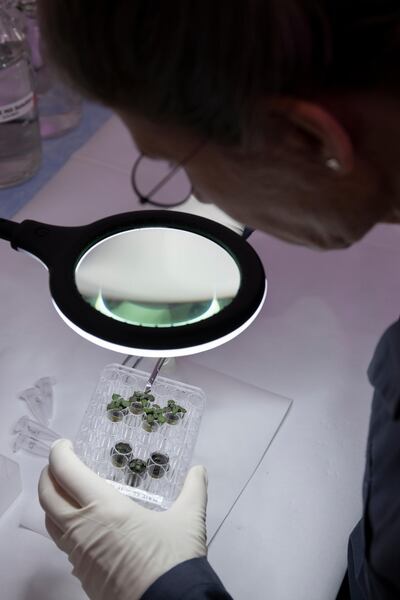Plants being grown in dusty soil recovered from Apollo missions to the Moon are a major breakthrough for future hopes of producing food in "lunar greenhouses" and sustaining human colonies in space.
In the first cultivation tests using Moon samples, scientists used tiny amounts of soil recovered during three Apollo missions in the 1960s and early 1970s to successfully germinate and grow a weed, thale cress, in a laboratory.
The plants did not grow in the powdery, contaminated Moon dust as well as they did in soil on Earth but the fact they developed at all is a hopeful sign that astronauts and visitors to the Moon could eventually become self-sustaining in food, according to the scientists involved in the study.
“The idea of bringing lunar soil into a lunar greenhouse is the stuff of exploration dreams, the stuff of science fiction,” said Robert Ferl, of the University of Florida, one of the authors of the study published in Communications Biology on Thursday.
“Showing that plants will grow in lunar soil is actually a huge step in the direction of being able to establish ourselves in lunar colonies.”
The study tried to grow thale cress ― a close relative of the mustard plant ― using four grams of soil recovered from each of the Apollo 11, 12, and 17 space missions conducted by the US space agency Nasa from 1969 to 1972.

Moon soil samples brought back to Earth included a sample scraped from behind the bumper of a moon rover along with 115 kilograms of rock and other materials during the Apollo 17 mission, the last time that human beings stepped on the Moon. The samples have been stored by the Johnson Space Centre in Houston, Texas, under laboratory conditions for the past five decades.
Moon soil lacks some of the key nutrients for healthy plant life on Earth with a lack of water, carbon, nitrogen and carbon. The samples contain sharp glassy deposits from ancient asteroid strikes and high levels of metallic iron.
The dusty, abrasive powder managed to get under the door seals of the Apollo spacecraft and damaged spacesuits, the researchers said.
“It’s not something you would want to breathe in, it would damage your lungs,” said one of the researchers, Stephen Elardo. “You wouldn’t want to put it in your garden to grow your tomatoes.”
But the researchers found that seeds were able to germinate in the Moon soil and appeared similar to samples grown from Earth-based soil.
“There was a tiny little sea of greenness on lunar greyness that was just astounding,” Mr Ferl said.
He said the plant started to suffer when compared with its Earth counterparts after the first five days as roots had to penetrate the soil.

The researchers said further studies were needed but there was no suggestion that plants grown using Moon soil would be toxic, even though some changed colour from green to purple.
They also discovered that the plants grew less well in material from the site of the Apollo 11 landing, where the soil was older than the other landing sites, with the soil damaged over longer periods by meteorite strikes and solar winds.
“It’s amazing that the plant still grows, it’s stressed but it doesn’t die, it doesn’t fail to grow at all, it adapts,” Mr Elardo said. “It’s pretty incredible to me that the plant is so hardy and adaptable that it can still grow in this harsh environment.”
Astronauts have already successfully grown plants and vegetables aboard the International Space Station, including cabbage and kale, but with materials brought from Earth.
Nasa is planning to send astronauts to the surface of the Moon from 2025, increasing interest in the prospect of a sustainable base to grow food, purify air and produce clean water.
“With Nasa and the world prepping themselves to go back to the Moon for longer excursions, it became much more relevant that we have to understand how resources … on the Moon can be used to further that exploration and make it easier and safer for astronauts and visitors,” said the study’s lead author, Anna-Lisa Paul.

